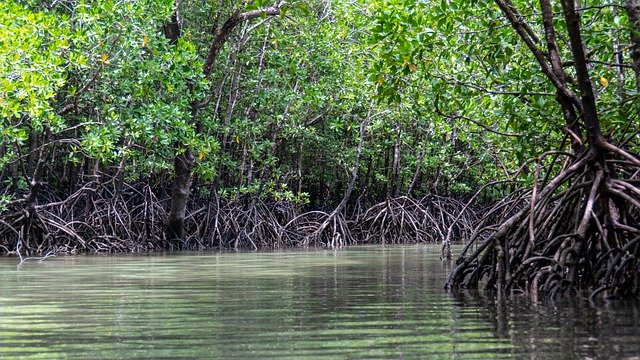INTRODUCTION
Mangroves: Mangroves are dense forests consisting of small trees, shrubs that preferably grow nearby coastal areas specifically in brackish water or saline water. Tropical coastal vegetation is often regarded as mangroves due to similar species of plants. Mangrove forests are usually found in tropical and subtropical regions.
MANGROVE BIODIVERSITY
Mangrove forests support a variety of biodiversity. Some common plants and animals found in mangroves are listed below.
| Common Plants | Vines, Ferns, Lilies, Orchids,
Floating mangrove propagules, Mangrove apple, Mangrove Palm, Red Mangrove, |
| Common Animals | anemones, sponges, worms, barnacles,
Monkeys, Lizards, Crocodiles, Snakes, Frogs, Bats, Flashing Flies, Royal Bengal Tigers, |
| IUCN Red List Species | hummingbird, Amazilia boucardi,
pygmy three-toed sloth |
| Birds | Ibises, Plovers, Herons, |
| Nesting Birds | Brown pelicans (Pelecanus occidentalis) |
| Fish | Mudskipper
Crabs, Oysters, Snails, |
Check out: Sustainable Forest Management – Methods and Importance
IMPORTANCE OF MANGROVES:
Mangroves are an important part of the Earth’s ecosystem.
1. Prevent Coastal Erosion: Mangrove forests are dense that hold sedimentation, prevent coastline erosions from wave actions.
2. Source of Livelihood: Many people are dependent on mangroves for their livelihoods as mangroves are breeding ground or many different types of shellfish. Fisheries hold economic importance.
3. Protection From Natural Catastrophic Events: Mangroves protect highlands from storm surges, seawater storms, floods as well as hurricanes and tsunamis etc.
4. Mitigate the Impacts of Climate Change: Mangroves absorb carbon from the atmosphere and help mitigate the effects of climate change. They can help us adapt to the impacts of climate change. Read our detailed article on Climate change adaption here: What is Climate Change Adaptation? – Importance and Methods.
5. Provide Habitat to Unique Biodiversity: Mangroves harbor unique and diverse biodiversity. Mangroves provide nesting sites to many birds as well as breeding sites for many types of shellfish.
CAUSES OF MANGROVES DESTRUCTION
The causes of mangrove destruction are listed below.
1. Water Pollution: Water pollution from oil spills is degrading the water quality of mangroves and threatening biodiversity.
2. Fertilizer Runoff: Fertilizer runoff containing pesticides is damaging the productive ecosystem.
3. Industrial Waste: Industrial waste/effluents getting discharged in mangroves are threatening the biodiversity living in the ecosystem.
4. Urbanization: Urbanization and housing schemes for increasing the human population are destroying the mangroves, as mangroves are drained and land is cleared to make space for urban projects.
5. Deforestation: Clearing forest cover for timber or illegal tree logging is a major cause of mangrove destruction.
6. Shellfish Over-exploitation or Farming: As mentioned in the importance of Mangroves, they are breeding ground for many different types of shellfish, so the growing demand leads to over-eploitation or farming of shellfish which destroys this diverse ecosystem. Also read: Impact of Marine Species Harvesting Industry on Environment.
7. Agriculture: Mangroves are drained and cleared to make land suitable for commercial farming of different commercial crops.
EFFECTS OF MANGROVES DESTRUCTION
Effects of mangrove destruction are costing the environmental sustainability and triggering the impacts of climate change.
1. Loss of Biodiversity: Mangrove destruction is causing habitat destruction and loss of biodiversity. For further information: Biodiversity Loss – Causes, Effects, and Solutions.
2. Environmental Degradation: Environmental degradation is getting increased due to mangrove destruction.
3. Coastal Erosion: The destruction of mangroves is contributing to coastline erosion from sea surges.
4. Global Warming: Mangrove destruction will release more carbon into the atmosphere leading to global warming.
5. Loss of Livelihoods: Due to the destruction of mangrove forests, many people are losing their source of livelihood.
You might also like to read: Threats to Natural Ecosystems – Causes, Effects, Management
CONSERVATION OF MANGROVES
Mangroves can be conserved by stopping and preventing mangrove destruction. Below the conservation methods have been listed.
1. Afforestation: Deforestation should be discouraged and afforestation/reforestation can help in conserving the mangrove forests.
2. Limiting Human Activities: Human activities such as urbanization should be limited around the mangrove forests.
3. Laws and Regulations: There should be an implementation of laws and regulations related to the protection and conservation of mangroves.
4. Join Local Government Initiatives: At an individual level, one can join protected areas initiatives launched by the local government in order to conserve mangroves.
5. Sustainable Approaches toward Fisheries: People who use mangroves for livelihoods should adopt sustainable approaches toward fisheries. Over-fishing should be avoided. To know more about it, read: World Fisheries And Impacts Of Fishery Over-Exploitation.
CONCLUSION
Mangrove forests hold huge economical and ecological importance. They are the most productive ecosystem on the planet. They harbor unique biodiversity. Many people around the world depend on mangrove forests for livelihoods. Human activities are damaging the productivity of mangroves. Conserving mangroves will help save the planet from increasing environmental pollution.
Also check out: Mangroves of Pakistan – Types, Importance, and Environmental degradation
I hope you all liked this post! Please comment below if you have any suggestions, comments, or feedback! We at #envpk love hearing from our readers! Thanks!





12 Comments
Good work, thanks
Thank you Adam, we are glad you found the article helpful!
Good work… useful info…. From india
Thank you Praneeth!
Nice work , It was really helpful for my upcoming presentation “Thank you so much for information”.
Thank you, we are glad you found our article helpful! And you are welcome.
Great work… useful info… thank u
Well done, thanks for sharing your knowledge.
Thank you!
This is a nice article!
Thanks!